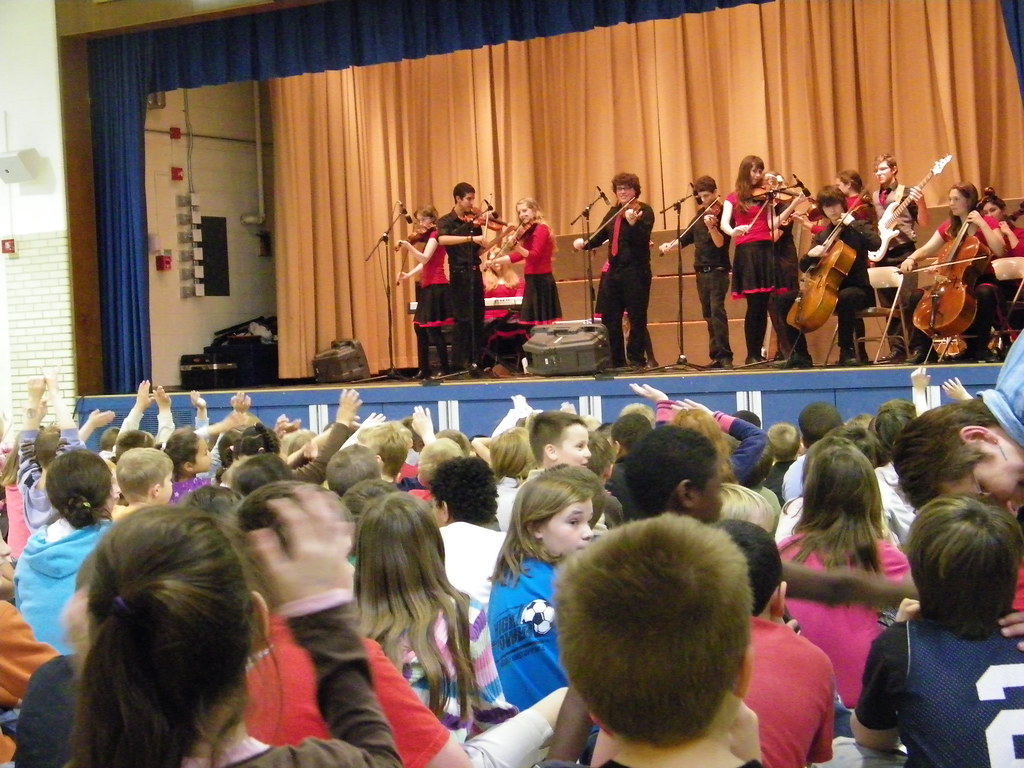Opinion: Dreaming About An Elementary School Performance Space

The performance space at Hamilton Elementary School, Westland, Michigan. Photo: Flckr.com (CC BY- NC-SA 2.0
Editor’s note: This is the second in a series of articles about envisioning a new elementary school. For the first installment in this series, look here.

In the early 1980s, two Mark’s Meadow teachers, 4th grade teacher Kirsten Lindblom and music teacher Mary May, attended a special workshop at the Metropolitan Opera in New York City. They returned full of enthusiasm and insight, and the tradition of the 4th grade opera was born. It occupied a major space in the lives of the children for several months because they did everything: imagined the plot, wrote the script, lyrics and music, designed and built the sets and costumes, and managed the stage -blocking, entrances. and movements. (Mary May transcribed the music and turned it into a stirring piano accompaniment.)
What were the stories the children told in their operas? Some may not remember themselves as 10-year-olds, but many will remember the drama of their own children’s tenth year. That was the year in which the body started changing, emotions became confusing, and girls leapfrogged over boys in their physical, emotional, and psychological development, while the boys, in response, followed their herd instinct and banded together for support and agency. And that was the year in which all sorts of social issues–bullying, loneliness, family strains, moving away or moving here– emerged. Anxiety, doubt, swagger, and awe competed on the playground. 4th grade was the end of childhood and the open door into adolescence. And all of this was gist for operatic treatment. The 4th grade opera was a rare peak into the lives of children as they performed in front of families, friends and peers.
This happened at Mark’s Meadow for many reasons, but one of those reasons was that, alone among the Amherst elementary schools, Mark’s Meadow had a genuine auditorium with permanent raked seating, a raised stage with backstage areas on both stage left and stage right, and crossover capability from one side to the other. Not even the high school auditorium had that! With the help of our wonderful custodians we constructed a curtain and some basic stage lighting, and we had a theater!
Children sang in public about things they would never talk about in private. They learned that being a backstage carpenter was every bit as important as having a role on stage. They learned to measure heavy cardboard and to manage stage fright. I could go on (and would love to) but perhaps you get the point: theater is the great metaphor which makes sense of curriculum!
As Amherst contemplates designing and building a new elementary school I want to emphasize the importance of a performance space. Although I have talked about 10-year-olds in this commentary, I could easily have written about 5-year-olds who gave a yearly circus for their parents and friends. I could have emphasized the faculty– all of us hams–who created and presented performances for the school community. All of us found being on stage both liberating and disciplining. We learned to take risks and unleash our imaginations. And imagination is the bedrock upon which learning is based.
The elements of a performance space need not be permanently fixed. Here are the essentials:
- A stage high enough, wide enough and deep enough, with steps to ground level on each side.
- Curtains – one across the width of the stage operated from either side of the stage and one on each side (or possibly screens) to create and hide the backstage areas.
- Basic stage lighting with dimmer switches.
- The semblance of raked seating, creating by seating mats for the youngest children, kindergarten-sized chairs for the early grades, 5th-grad sized chairs for older children and full-sized folding chairs for adults and guests.
- Acoustical treatment so that children will not require mics or other amplification. Acoustics is always a mystery, even to acoustical engineers, so that portable baffles and sound-absorbing panels which help focus sound and thrust it forward is no doubt preferable to built-in efforts which may not work. The architects should provide specifics about their acoustical engineering, including materials, placement and portability.
- Provision for set construction and storage somewhere in the school building. This space could also be used for other science and shop purposes throughout the year.
No other age span in educational institutions is as wide (or as wild) as the span of ages 5 to 11 in elementary school, from toddlerhood to adolescence. Performance, for younger children, is in the realm of “let’s pretend.” For the middle ages in that range, it allows for “let’s imagine.” And for the oldest children, it’s “let’s imagine ourselves.” Learning, performing and teaching are the three central activities of elementary school education and school architecture should provide for all of them.
Michael Greenebaum was Principal of Mark’s Meadow School from 1970 to 1991, and from 1974 taught Organization Studies in the Higher Education Center at the UMass School of Education. He served in Town Meeting from 1992, was on the first Charter Commission in 1993, and served on several town committees including the Town Commercial Relations Committee and the Long Range Planning Committee.
